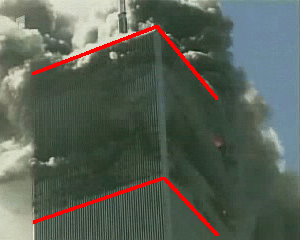Re: you know what's astonishing?
First, how does Blanchard really know that that cloud of dust outside of the bounds of the building represents 95% of the upper floor mass at the moment of those pictures? Determining that off of a picture is probably highly speculative, especially when you can't see into the cloud. And keep in mind that the building is not at a stand-still at the time of the picture; there is an ongoing kinetic energy transfer from one floor to the next as collapse continues, and it is difficult to determine the true state of the mass and the acting kinetic energy upon the lower structure at that time just by looking at the photograph.
I think a more scientific estimation of kinetic energy requirements relative to the remaining mass above the building as well as the transfer of that energy from one floor to the next is needed to make a good conclusion rather than to just say, "Gee, it looks like there is not enough mass remaining from the upper floors for the collapse to continue."
But if I don't assume that there was enough kinetic energy there to continue the collapse, then I'd have to assume that there were explosives charges all the way down the building and that someone was setting them off in sequence to create a continued "downward" disintegration of the building. Aside from that being a highly complicated operation with little to no evidence at this point, this is not even the technique that controlled demolitions would use. They typically set charges low on the structure and harness the power of gravity upon the vast majority of the building mass to bring the entire thing down.
As far as I know, most demolitions folks, structural engineers, and physicists also tend to see it this way, certainly the few that I have spoken with... so I'm not sure why I should trust the opinion of one software engineer (even if a smart one) over the collective input of experts in the field.
First, how does Blanchard really know that that cloud of dust outside of the bounds of the building represents 95% of the upper floor mass at the moment of those pictures? Determining that off of a picture is probably highly speculative, especially when you can't see into the cloud. And keep in mind that the building is not at a stand-still at the time of the picture; there is an ongoing kinetic energy transfer from one floor to the next as collapse continues, and it is difficult to determine the true state of the mass and the acting kinetic energy upon the lower structure at that time just by looking at the photograph.
I think a more scientific estimation of kinetic energy requirements relative to the remaining mass above the building as well as the transfer of that energy from one floor to the next is needed to make a good conclusion rather than to just say, "Gee, it looks like there is not enough mass remaining from the upper floors for the collapse to continue."
But if I don't assume that there was enough kinetic energy there to continue the collapse, then I'd have to assume that there were explosives charges all the way down the building and that someone was setting them off in sequence to create a continued "downward" disintegration of the building. Aside from that being a highly complicated operation with little to no evidence at this point, this is not even the technique that controlled demolitions would use. They typically set charges low on the structure and harness the power of gravity upon the vast majority of the building mass to bring the entire thing down.
As far as I know, most demolitions folks, structural engineers, and physicists also tend to see it this way, certainly the few that I have spoken with... so I'm not sure why I should trust the opinion of one software engineer (even if a smart one) over the collective input of experts in the field.








Comment